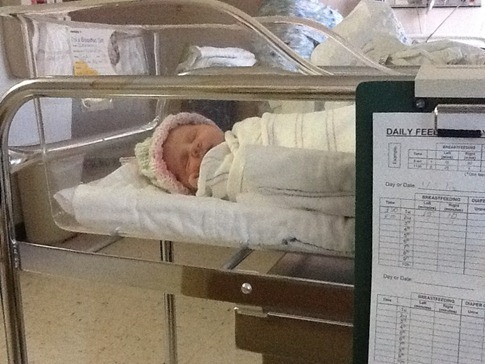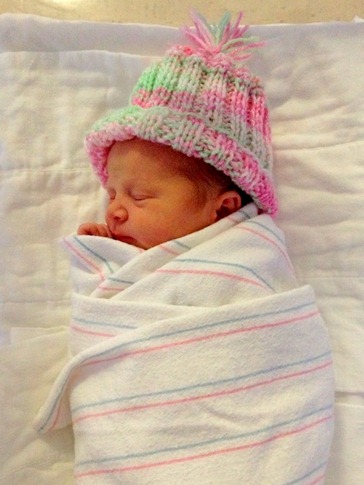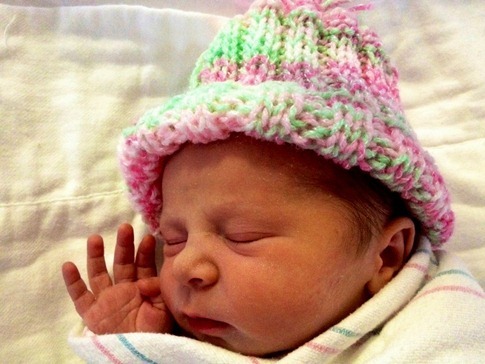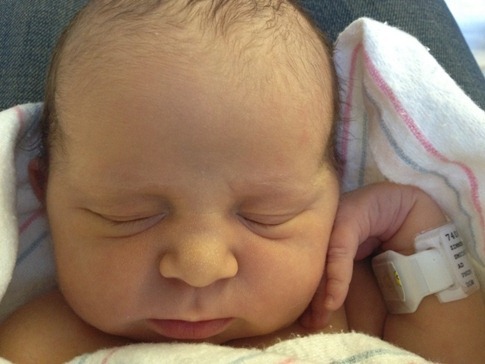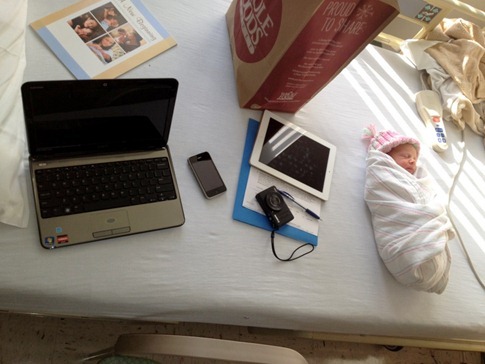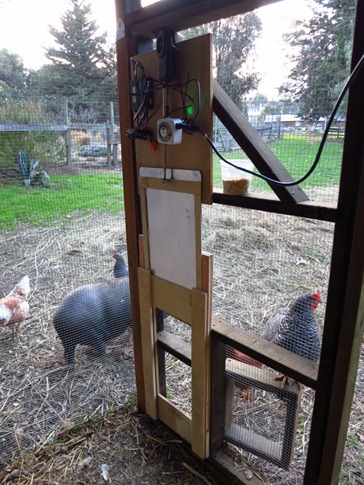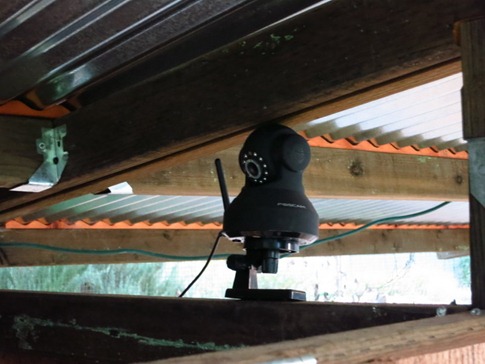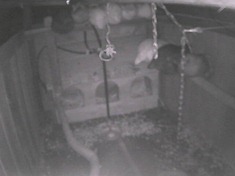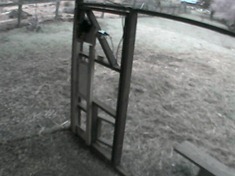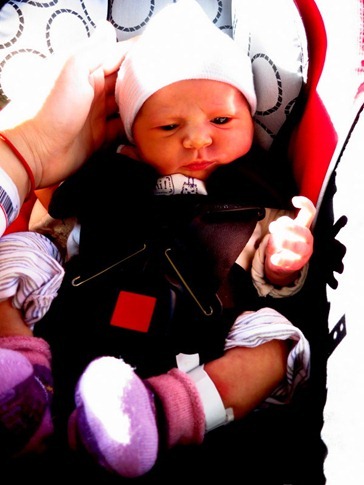And then everyone left the hospital room. The doctor, nurses, our moms. It was just us and this hours-old baby. Fortunately, exhaustion overpowered anxiety and our minimal newborn training kicked in enough to dig through the drawers on the rolling bassinet - more of a clear tub on a metal cart - to find some clean diapers. With Ann laid-out from the surgery and groggy from the drugs, the task of wiping away the sticky black meconium (a tar-like substance made of up everything the baby ingests while in the uterus: amniotic fluid, bile, mucus) that seemed to be in every crevice from front to back fell to me. While I’d later learn that this secretion is all but sterile, I winced and gagged as I cleaned the girl parts for which I’d never before been completely responsible as best I could. I found it helpful to pretend I was wiping caked grease off the swing arm bearings on my ‘73 Honda CB750, and this stuff was about as gooey. They’d warned us that newborns aren’t able to regular their temperature for the first 48 hours (and consequently had denied Ann’s request for a fan in the stuffy room), so I executed my best swaddle and pulled one of the knit caps the Petaluma Ladies Auxiliary makes for the nursery down over her tiny head. She, thankfully, fell deeply asleep.
But a few hours later, in a pattern that would surely repeat itself in some form or another for the next year or so, our little angel woke up crying. Actually, Ann heard her crying and had to yell across our long thin hospital room to my bed on the opposite wall to wake me. It seems that while Ann was already keyed into the sound of our baby crying, I was still only conditioned to rouse when Ann called. I jumped out of bed and scooped up our tightly swaddled bundle, wailing wildly by this point. Fortunately, I remembered a technique I’d seen some friends use with their newborn - I call it “the broken elevator” – in which they let the baby fall suddenly only to be caught softly at the bottom of the drop. It worked! A few of these seemed to snap her out of her panic, likely as she saw her short life pass before her eyes, thinking the ground floor was coming up fast.
I also remembered another tip, this one gleaned from a book given to me for Christmas by Ann’s brother, himself a new father. Be Prepared: A Practical Handbook for New Dads had advised that the most effective way to soothe a baby was to mimic the walking motion of the mother. Turns out, most people take about one step each second, and the reggae beat of Bob Marley’s “Buffalo Soldier” just happened to be at 60 beats per minute. With my free hand, I grabbed my iPhone off the bedside table and swiped to a metronome app I’d downloaded one time after swearing to work on my timing on the mandolin. I keyed in 60 beats per minute and bounced around the room like a college student just off the plane in Kingston as Wynne drifted happily back to sleep.
The second day in the hospital consisted of extended and repetitive photo sessions and mass social media announcements. As I commented online, “The only thing that makes you feel more popular than birthdays on Facebook is apparently... well... birth days on Facebook.”
The picture below seemed to be everyone’s favorite…
It was great to have Ann’s mom in town during our days in the hospital, both to have someone taking care of the farm and to bring us meals from our freezer and the nearby Whole Foods. Though we told the nurses each day that we wouldn’t be needing the hospital meal tray included with Ann’s stay (I was forced to go downstairs to “Dr. Beans” for bagels and coffee), it inevitably showed up, and we’d politely send it back. They told us later that our rejected meals had been feeding the other fathers on the floor.
We’d also told Ann’s mom that nothing really needed to be done on a daily basis at the farm since the automatic chicken door was working and everyone had plenty of food.
We had neglected to mentioned however, that in addition to free-ranging around the pasture, several of the chickens had also taken to finding holes in the fence and roaming around the sun garden, shade garden, lawn and driveway. They would always find their way back to the coop each day before the door closed automatically. In fact, each night we would confirm their safe return - much to the amusement of the nurses - via a wireless web cam in the chicken coop that could be remotely rotated to see all the girls up on their roosts and the silver coop door securely closed.
But Ann’s mom didn’t know that. She returned from a hospital visit to find chickens everywhere and spent the rest of the day frantically chasing them around and shooing them back into the pasture only to have them magically reappear behind her. Counting them proved all the more difficult since she had been sure we had ten chickens; We only had nine. We explained all this when she called us at the hospital, exasperated. We felt a little bad for all the effort she’d gone to, but also that we hadn’t been watching the web cam while she was out there herding chickens. It would have been pretty tempting to have used the two-way audio capability of the web cam to mess with her. “Bok bok! You can’t catch us! I’m over here! Behind you!”
Back in the hospital, we had two patients in our room, Ann and Wynne, so the door was never closed longer than 20 minutes before another nurse would walk in to take vitals or review the feeding and diaper records we’d been told to keep (for Wynne). When we’d neglected to record an entry in the middle of the night because one of the nurses had not returned our chart, panic flowed through the chain of care all the way to our pediatrician, and we were roundly reprimanded for letting the baby go more than 3 hours between feedings (which we hadn’t). Frankly, we’d had enough of the supervision.
That is, until about 3 am on the second night when Wynne woke up crying inconsolably. Soon, her face turned tomato red, and she seemed to stop breathing between wails. No amount of near-death elevator-related simulated mishaps could snap her out of it. When white foamy bubbles began coming from her mouth, we panicked and rang the nurse call button. When the nurse came in, she explained that the white bubbles were the remaining fluid in the stomach that had not been suctioned in the operating room and would have been squeezed out during a vaginal birth. “She’s normal,” the nurse said. Then she looked at us and asked, “First time parents?” When we looked up with bloodshot eyes, hearts still beating in fright, and nodded, she said, “You’re normal too.”
And we got further confirmation of that fact soon after. Another new parent friend had told us that we should let the nurses take the baby to the nursery at night so we could get some sleep. We’d brushed it off figuring that sleep deprivation was inevitable, but after our recent frothing fright, we were fried. The room went dark and silent once Wynne was rolled out the door in her plastic tub, and I drifted off immediately. Once again, I was awakened soon after by Ann’s voice and, once again, she was sure she heard Wynne crying out the door, past the nurses’ station, down the hall and in the nursery. It’s amazing how quickly that motherly instinct kicks in.
The nurse we called at 3:00 am had also given us a little bit of extra advice, “If they’re red, they’re okay. If they’re blue, something’s wrong.” When we met our pediatrician for the last time before leaving the hospital, we grilled him for more simple wisdom we could follow at home before calling 911 (!). He mentioned the irregular breathing patterns of newborns and basically trying not to focus on them to avoid worrying constantly. A good tip. Now, we’re not really worriers, but we’re not really overly casual either. Yes, we drove 10,000 miles over 5 months through Mexico and Central America where our family and friends assured us we would be robbed, kidnapped and killed within miles of the US border (ironically enough, probably the most dangerous area!), but we also planned and researched for a year and prepared ourselves, our vehicle and our gear extensively before leaving. And before our next adventure, having a baby, we’d similarly done our homework and knew what we were getting into. And because of that, we knew that our baby girl would go through a mini menstruation in which she would discharge blood into her diaper and that we might find brick-colored specks once her kidneys started to function. I mean, these are the “911 moments” we were trying to avoid and yet no one at the hospital found it necessary to mention either. One Google search shows that new parents are freaking out about these things on a minute by minute basis. How about a little heads up, medical professionals?
So like all new parents do, we left the hospital on a Saturday afternoon feeling a bit on our own but excited to be bringing our new baby home. We walked through the sliding automatic doors and into the parking lot carrying the car seat we’d brought to the hospital empty, now occupied by a tiny human we’d created from scratch. Ann sat in the back seat worriedly watching her breathing while I craned to see the mirror we’d mounted in the back seat to double check.
It’s notable how similar the feel of that drive was to the day we pointed our truck south…

